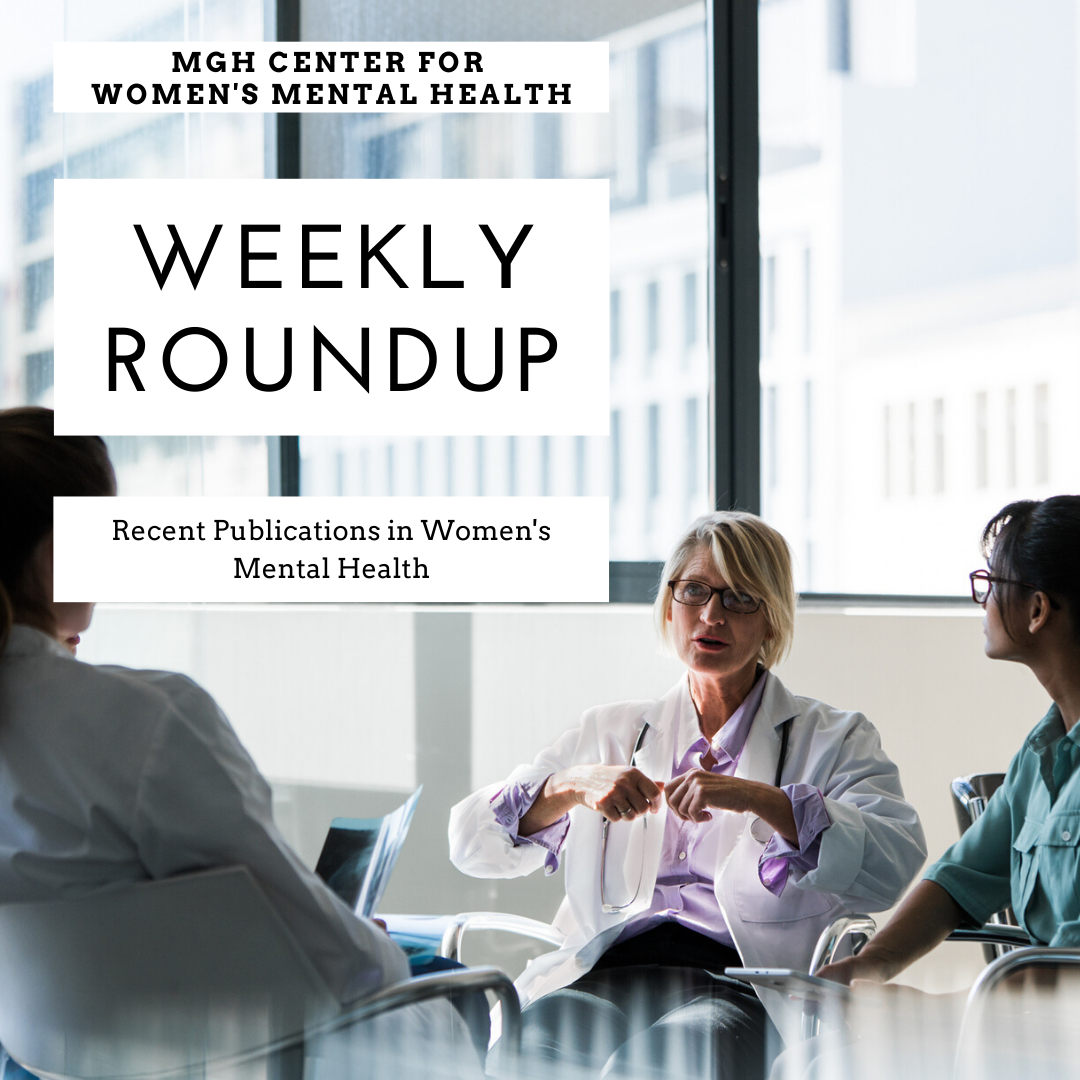Every week we review the most recent publications in women’s mental health, covering topics related to premenstrual symptoms, perinatal mood and anxiety disorders, use of medications in pregnant and breastfeeding women, perinatal substance use, and menopausal mental health.
Galbally and colleagues look at the motor development of children exposed to antidepressants in utero. The findings of this study demonstrate an inconsistent pattern of associations with prenatal antidepressant exposure across the neuropsychological subtests of sensorimotor and visuospatial processing. We will discuss this study in greater detail on January 19th.
Another article is a systematic review and meta-analysis looking at delivery outcomes in pregnancies exposed to benzodiazepines (Grigoriadis et al, 2020). While benzodiazepines (BZDs) are commonly prescribed during pregnancy, there is limited information regarding the impact of BZDs on pregnancy and delivery outcomes. We will be reviewing this study in greater detail as well.
For more detailed descriptions of many of these topics, you can sign up to receive our weekly CWMH NEWSLETTER which comes out every Thursday.
Ruta Nonacs, MD PhD
PMS AND PMDD |
| Addictive behaviors across the menstrual cycle: a systematic review.
Joyce KM, Good KP, Tibbo P, Brown J, Stewart SH. Arch Womens Ment Health. 2021 Jan 6. Thirty-four articles examining alcohol use, cannabis use, nicotine use, caffeine use, and gambling behavior across menstrual cycle phase met inclusion criteria. Consistent with self-medication theory, strong evidence indicated that nicotine use increased premenstrually and menstrually. Results were less consistent or understudied for other addictive behaviors and thus conclusions cannot be drawn.
|
INFERTILITY AND MENTAL HEALTH |
| No articles this week
|
PSYCHIATRIC ILLNESS DURING PREGNANCY |
| No articles this week
|
MEDICATIONS AND PREGNANCY |
| Active Surveillance of the Safety of Medications Used in Pregnancy.
Huybrechts KF, Kulldorff M, Hernández-Díaz S, Bateman BT, Zhu Y, Mogun H, Wang SV. Am J Epidemiol. 2021 Jan 11. Researchers apply and evaluate a tree-based scan statistic data mining method (TreeScan) as a safety surveillance approach that allows for simultaneous evaluation of a comprehensive range of adverse pregnancy outcomes, while preserving the overall false positive rate. Grigoriadis S, Graves L, Peer M, Mamisashvili L, Ruthirakuhan M, Chan P, Hennawy M, Parikh S, Vigod SN, Dennis CL, Steiner M, Brown C, Cheung A, Dawson H, Rector N, Guenette M, Richter M. Can J Psychiatry. 2020 Dec;65(12):821-834. While exposure to benzodiazepines was associated with increased risk for certain adverse outcomes, it is possible that confounding variables also play a role in modulating risk. Antidepressant exposure in pregnancy and child sensorimotor and visuospatial development. Galbally M, Watson SJ, Spigset O, Boyce P, Oberlander TF, Lewis AJ. J Psychiatr Res. 2020 Nov 25. The findings of this study demonstrate an inconsistent pattern of associations with prenatal antidepressant exposure across the neuropsychological subtests of sensorimotor and visuospatial processing. Melov SJ, Shetty PS, Pasupathy D, Kirby A, Sholler GF, Winlaw DS, Alahakoon TI. Prenat Diagn. 2020 Oct 17. Maternal mood disorders with and without SSRI or SNRI use, maternal age >40 years and lack of multivitamin/folate use to be independently associated with CHD in pregnancy.
|
POSTPARTUM PSYCHIATRIC ILLNESS |
| Phenomenology, Epidemiology and Aetiology of Postpartum Psychosis: A Review.
Perry A, Gordon-Smith K, Jones L, Jones I. Brain Sci. 2021 Jan 4;11(1):E47. Free article. Review. Schobinger E, Stuijfzand S, Horsch A. Front Psychiatry. 2020 Dec 22;11:562054. Free article. At 1 week postpartum, 63.9% of mothers and 51.7% of fathers presented symptoms of acute stress disorder. At 1 month postpartum, 20.7% of mothers and 7.2% of fathers had symptoms of post-traumatic stress disorder. Acute stress disorder was a predictor of postpartum post-traumatic stress disorder (Odds ratio: 8.6, IC 95% [1.85; 40.42]). Dowlati Y, Meyer JH. Arch Womens Ment Health. 2020 Nov 17. Presently, development of dietary supplements and hormonal products for prevention of PPD is at an early stage with most trials showing results that are either preliminary, not definitive, trend level or variable across studies. Polycystic Ovary Syndrome and Postpartum Depression Symptoms: A Population-Based Cohort Study. Koric A, Singh B, Vanderslice JA, Stanford JB, Rogers CR, Egan DT, Agyemang DO, Schliep K. Am J Obstet Gynecol. 2021 Jan 4: S0002-9378(20)32632-6. Clinical PCOS was associated with a 1.76 (95% confidence interval (CI), 1.03-3.00) higher adjusted prevalence ratio (aPR) for postpartum depressed mood after controlling for age, pre-pregnancy BMI, race/ethnicity, education, and marital status. Prenatal depression and anxiety mediated 20% and 32% of the effect of clinical PCOS on postpartum depressed mood and anhedonia, respectively. Using the Penn State Worry Questionnaire in the Peripartum. Voegtline K, Payne JL, Standeven LR, Sundel B, Pangtey M, Osborne LM. J Womens Health (Larchmt). 2021 Jan 12. The PSWQ correlated well with all psychological scales, especially TRAIT anxiety. Worry appears to be a major component of perinatal anxiety, and the PSWQ may be a valuable tool for more precise specification of the clinical phenotypes of perinatal anxiety. Adverse childhood experiences and maternal anxiety and depression: a meta-analysis. Racine N, Devereaux C, Cooke JE, Eirich R, Zhu J, Madigan S. BMC Psychiatry. 2021 Jan 11;21(1):28. Free article. A total of 15 studies (N = 7788 participants) were included. ACEs confer risk to maternal mental health, albeit effect sizes are small to moderate in magnitude. Cowell W, Colicino E, Askowitz T, Nentin F, Wright RJ. Biol Sex Differ. 2021 Jan 6;12(1):6. Free article. In this study carried out in the Northeastern US, male fetal sex was associated with the onset of depressive symptoms during the postnatal period (odds ratio [OR] = 5.24, 95% confidence interval [CI] = 1.93, 14.21). Koukopoulos AE, De Chiara L, Simonetti A, Kotzalidis GD, Janiri D, Manfredi G, Angeletti G, Sani G. J Affect Disord. 2020 Sep 1:S0165-03 Althaus AL, Ackley MA, Belfort GM, Gee SM, Dai J, Nguyen DP, Kazdoba TM, Modgil A, Davies PA, Moss SJ, Salituro FG, Hoffmann E, Hammond RS, Robichaud AJ, Quirk MC, Doherty JJ. Neuropharmacology. 2020 Dec 15;181:108333. Zuranolone is a potent and efficacious neuroactive steroid GABAA receptor positive allosteric modulator.
|
MEDICATIONS AND BREASTFEEDING |
| No articles this week
|
PERINATAL SUBSTANCE USE |
| Chronic prescription opioid use in pregnancy in the United States.
Straub L, Huybrechts KF, Hernandez-Diaz S, Zhu Y, Vine S, Desai RJ, Gray KJ, Bateman BT. Pharmacoepidemiol Drug Saf. 2021 Jan 11. 1.50% of 975 169 Medicaid-insured and 0.32% of 1 037 599 commercially insured beneficiaries filled opioid prescriptions for ?90 days’ supply; 0.78% (Medicaid) and 0.17% (commercially insured) filled prescriptions for ?180 days’ supply.
|
MATERNAL MENTAL HEALTH AND CHILD OUTCOMES |
| Bipolar offspring and mothers: interactional challenges at infant age 3 and 12 months-a developmental pathway to enhanced risk?
Anke TMS, Slinning K, Moe V, Brunborg C, Siqveland TS, Skjelstad DV. Int J Bipolar Disord. 2020 Aug 31;8(1):27. Free article. In mother-infant dyads where the mother has bipolar disorder, this study demonstrated significantly more challenges in all three interaction domains at infant age 12 months compared to the dyads where the mother did not have bipolar disorder. Prenatal and postnatal depressive symptoms, infant white matter, and toddler behavioral problems. Borchers LR, Dennis EL, King LS, Humphreys KL, Gotlib IH. J Affect Disord. 2020 Dec 24;282:465-471. Depressive symptoms during pregnancy may affect infant corpus callosum development and, in turn, offspring behaviors.
|
MENOPAUSE AND MENTAL HEALTH |
| Longitudinal Association Between Depressive Symptoms and Multidimensional Sleep Health: The SWAN Sleep Study.
Bowman MA, Kline CE, Buysse DJ, Kravitz HM, Joffe H, Matthews KA, Bromberger JT, Roecklein KA, Krafty RT, Hall MH. Ann Behav Med. 2021 Jan 7:kaaa107. Higher depressive symptoms were associated with subsequent poorer multidimensional sleep health (p < .0.001) and lower alertness (p < .0001) and satisfaction with sleep (p < .0001).
|
OTHER TOPICS IN WOMEN’S MENTAL HEALTH |
| No articles this week |




Leave A Comment